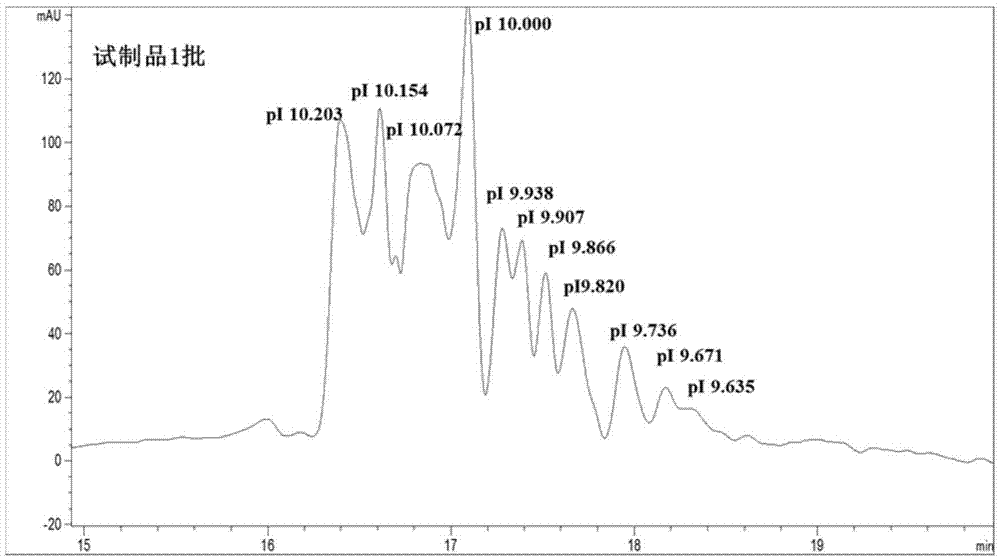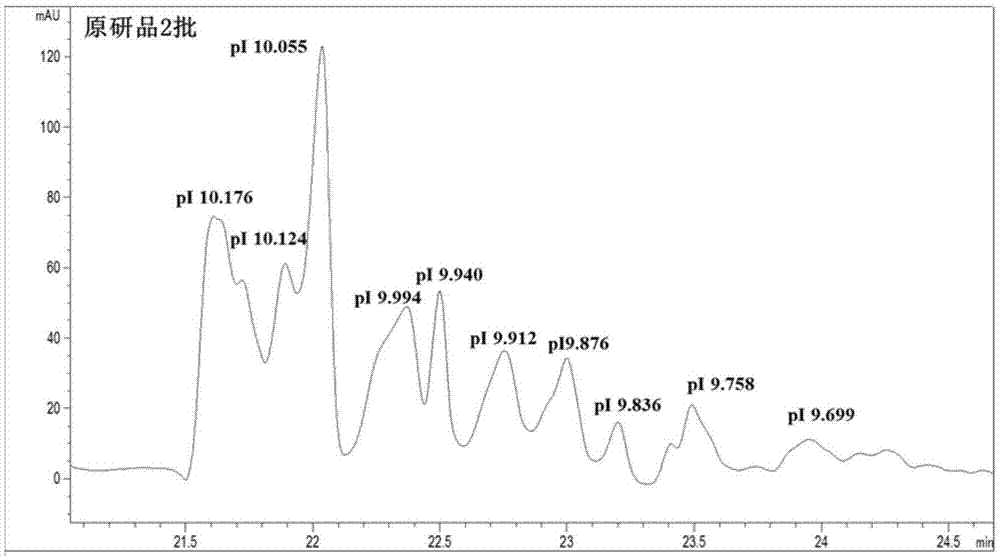Capillary isoelectric focusing analysis method for polypeptide polymer
A technology of isoelectric focusing and analysis method, which is applied in the direction of material analysis, analysis material, and measurement device by electromagnetic means, and achieves the effect of high accuracy, low cost and fast speed.
- Summary
- Abstract
- Description
- Claims
- Application Information
AI Technical Summary
Problems solved by technology
Method used
Image
Examples
Embodiment 1
[0058] Prepare capillary isoelectric focusing sample solution according to the composition in Table 1, place it in the autosampler of Agilent7100 capillary isoelectric focusing instrument, and use fluorine-coated capillary assembly (Agilent / 194-8111) to analyze the sample. The distances between the detector windows are 8.5cm and 24.5cm, respectively. The capillary electrophoresis system was equipped with an external water bath set at 15 °C. 2bar high pressure injection for 100s, 25kV focusing for 9min at 15°C, 200mM phosphoric acid as the anolyte, and 300mM sodium hydroxide as the catholyte. Migration conditions: 30kv migration 45min. The detection was performed at 280nm, and the isoelectric point of the measured sample was calculated using openLAB ControlPanel software. See Table 2 for the isoelectric points of each component of the trial-produced sample and the reference substance, and see the attached figure 1 , with figure 2 . Table 1 Proportion of loading solution f...
Embodiment 2
[0063] Prepare capillary isoelectric focusing sample solution according to the composition in Table 3, place it in the autosampler of Agilent7100 capillary isoelectric focusing instrument, and use fluorine-coated capillary assembly (Agilent / 194-8111) to analyze the sample. The distances between the detector windows are 8.5cm and 24.5cm, respectively. The capillary electrophoresis system was equipped with an external water bath set at 15 °C. 2.5bar high-pressure injection was used for 80s, at 15°C, 30kv focusing for 15min, the anolyte was 200mM phosphoric acid, and the catholyte was 300mM sodium hydroxide. Migration conditions are: 30kv migration for 40min. The detection was performed at 280nm, and the isoelectric point of the measured sample was calculated using openLAB ControlPanel software. The electrophoretic patterns of the trial samples and reference substances are attached image 3 , with Figure 4 .
[0064] Table 3 Proportion of sample solution for capillary isoel...
Embodiment 3
[0067] Prepare capillary isoelectric focusing sample solution according to the composition in Table 4, place it in the autosampler of Agilent7100 capillary isoelectric focusing instrument, and use fluorine-coated capillary assembly (Agilent / 194-8111) to analyze the sample. The distances between the detector windows are 8.5cm and 24.5cm, respectively. The capillary electrophoresis system was equipped with an external water bath set at 15 °C. 2.5bar high-pressure injection was used for 80s, at 15°C, 30kv focusing for 15min, the anolyte was 200mM phosphoric acid, and the catholyte was 300mM sodium hydroxide. Migration conditions are: 30kv migration for 40min. The detection was performed at 280nm, and the isoelectric point of the measured sample was calculated using openLAB ControlPanel software. The electrophoretic patterns of the trial samples and reference substances are attached Figure 5 , with Figure 6 .
[0068] Table 4 Capillary isoelectric focusing sample solution r...
PUM
| Property | Measurement | Unit |
|---|---|---|
| wavelength | aaaaa | aaaaa |
Abstract
Description
Claims
Application Information
 Login to View More
Login to View More - R&D
- Intellectual Property
- Life Sciences
- Materials
- Tech Scout
- Unparalleled Data Quality
- Higher Quality Content
- 60% Fewer Hallucinations
Browse by: Latest US Patents, China's latest patents, Technical Efficacy Thesaurus, Application Domain, Technology Topic, Popular Technical Reports.
© 2025 PatSnap. All rights reserved.Legal|Privacy policy|Modern Slavery Act Transparency Statement|Sitemap|About US| Contact US: help@patsnap.com



